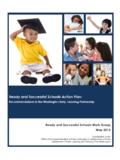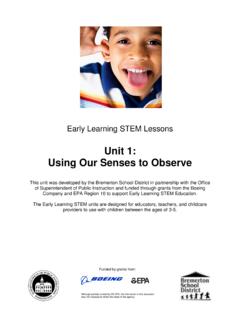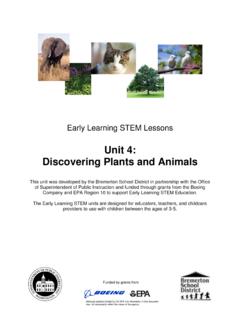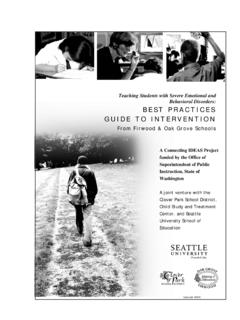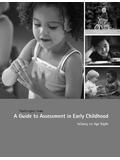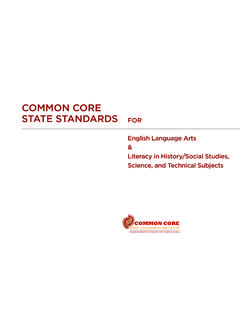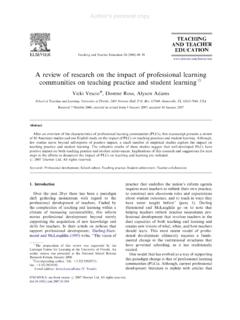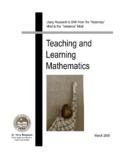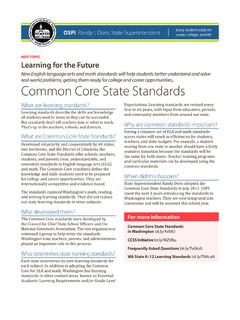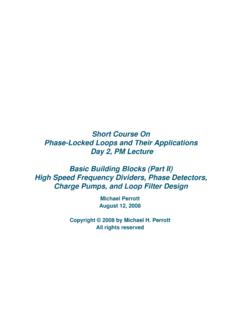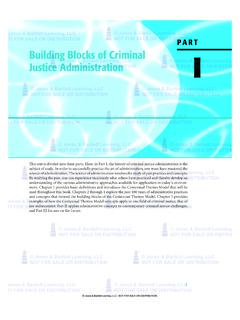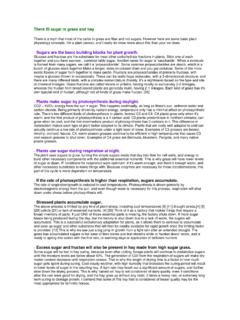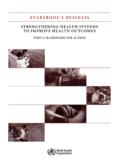Transcription of Early Learning STEM Lessons Unit 2: Building Structures ...
1 Early Learning STEM Lessons Unit 2: Building Structures and exploring Shapes This unit was developed by the Bremerton School District in partnership with the Office of Superintendent of Public Instruction and funded through grants from the Boeing Company and EPA Region 10 to support Early Learning STEM Education. The Early Learning STEM units are designed for educators, teachers, and childcare providers to use with children between the ages of 3-5. Funded by grants from Although partially funded by US EPA, the information in this document may not necessarily reflect the views of the Agency. Objectives Children will build Structures using varying materials ( , different types of blocks, straws, newspapers, etc.). Children will make observations about materials and compare/contrast them. Children will make observations about Structures and use key vocabulary terms to compare/contrast.
2 Children will identify basic and advanced shapes regardless of size or orientation Common Misconceptions A shape can only look one way. Young children can become stuck on the idea that a shape is only a shape if it looks the same. For example, they may believe that a triangle with the point down is not a triangle, or that a long skinny rectangle and a shorter fat rectangle cannot both be rectangles. You can avoid this misconception by having many different types of the same shapes and talking about similarities and differences. When asking children to identify a shape, ask them to tell you how they know what the shape is. Target Books Nonfiction (Informational Text): Design it! Build it! by Susan Ring o Real-life illustrations are used to describe characteristics of different types of Structures and the process of Building . Questions about the design and necessary characteristics of various Structures are included.
3 Fiction: The Shape of Things by Dayle Anne Dodds o Colorful cartoon images illustrate different shapes that can be seen in everyday life. Rhyming text names the key shape, and then adds additional information to turn that shape into an everyday life item such as a house or egg. Hot Rod Hamster by Cynthia Lord o A hamster sets out to build a hot rod, selecting different characteristics that will meet his needs for speed, size, and color Key Vocabulary Length How long something is Height how tall something is Weight how heavy or light something is Build to put things together and create something Materials things being used to build Shape the way something is formed, circles, squares, and triangles are all shapes o Beginning Shapes Circle Heart Oval Rhombus (commonly referred to as a diamond). Rectangle Unit 2 Building Structures and exploring Shapes. Version 2, 10/2013 2. Square Star Triangle o Advanced Shapes Crescent Cube Cylinder Hexagon Octagon Pentagon Pyramid Sphere Design A plan of the shapes, sizes, colors and Building materials needed to create something Model A small copy of a structure structure A Building or something built of parts arranged in a special way Support To hold up or keep something from falling Tower Tall structure or Building Bridge A long structure to go across and above something like a river or road Pre/Post Assessment Ideas Using the provided sample block design matching worksheet or creating your own (hand drawn tracing around your own pattern blocks, computer generated, or photographs), have children look at a picture that is missing a shape.
4 Ask questions such as: o What is the shape missing? . o What can be used to fill in that spot? . o Are there other shapes that they could use to fill in the hole? . Using the same worksheet as referenced above or by creating your own, have children fill in a given shape using the blocks. Ask, How many pieces did you need? Is there another way to build the shape? . Use pattern blocks to make pictures (or buy a commercial set) and see if children are able to match the shapes. This can be easier or harder by changing the visual cues given. For example, an easy task would include the entire shape outlined and colored in with the matching color of the required block. Whereas, a harder option would be to have only a black outline of the entire picture without any clues to the shapes or colors of the blocks that are used. You can also vary the difficulty by changing how many blocks you give them.
5 Ask children to build a tower using a set number of blocks. Vary the number you tell them to use based on the child's age and ability. Younger children may only use a set number to ten, while kindergarten bound children may be able to count out and use 30 blocks. o Observe how children count out the blocks. Are they able to count with rationality (one number word for each block)? Can they count in Unit 2 Building Structures and exploring Shapes. Version 2, 10/2013 3. sequence? Do they stop when they get to the number you requested or do they keep going? o Observe the creation of their tower. Are they able to stack the blocks without them falling? Do they try and problem-solve issues that may arise such as the stability of a structure or continue to attempt to build the same way? How complex is their structure ? Are they stacking blocks one on top of another or Building more complicated designs using variations in block orientation and spacing?
6 Before Reading Introduce key vocabulary. Take a picture walk'-look through the pages and talk about what they see and think the story may be about; when appropriate, have children make predictions about what they think may be happening on a page. Record predictions that children make during their picture walk. Record what children already know about the topic, a circle map can be an excellent recording tool - examples are at the end of the unit. During Reading Make comments about personal connections, either between you and the story or the children and the story. Ask questions that are: o On the page - basic level questions that have yes/no answers or can be answered by looking at the page. o Between the lines - a higher level of questioning that requires children to recall information in order to answer. o Beyond the book - an advanced level of questioning that requires children to take information they have previously heard and make reasonable predictions based on known information.
7 A bookmark that contains key vocabulary and a variety of types of questions specific to each book is included with the unit. It is recommended that you print the bookmark and keep it with your book copy to serve as a reference guide when engaging with the book with young children. Book Extension Build a house or Building for a stuffed animal or doll using different materials such as blocks, boxes, containers, toilet/paper towel tubes, sticks, leaves, etc. o Have children select an object they will be constructing a house or other Building for. Some examples might include Building a house for a doll or toy animal or a garage for a toy car or airplane. o Have children study different buildings and see how different needs are met. Ask questions such as: How are houses for people different from a dog house? . How are those different from a garage or a shed? . What things will their object need-a wide doorway to get in, or a chair to sit on?
8 Unit 2 Building Structures and exploring Shapes. Version 2, 10/2013 4. o Using the gathered materials, let children build their Structures . Encourage the children to notice details about their construction such as how the pieces stick together or what materials make good walls. Have them test their structure to see if it is adequate for its purpose. Does it work or do they need to go back and redesign a part of their structure ? o Children may then create a blueprint, or draw their design. Emphasize the shapes, colors, and the process of drawing, rather than the quality. Older children may be able to be more accurate in their drawings, representing the sizes, shapes, and differences in the materials compared with younger children, who may make more lines and scribbles. After children have drawn their blueprints, have them tell you about their drawings. Ask them details such as structure type, inhabitants, shapes, and materials they used.
9 O Bind these blueprints into a classroom book, allowing children to use them as a reference when Building at other times. o For an additional challenge, have children draw their blueprints prior to the construction phase, and then use their blueprints as a reference when Building . Allow changes to their plans, as that is what all good engineers do! Discussion Points Encourage children to talk about why they are doing something a certain way. Prompt them with questions about block placement putting heavy blocks on the bottom vs. the top. Ask about the materials they used. Talk about the changes they are making as they build their structure . Why did they stop making it so tall and instead build longer walls? If they tried making a roof from the cardboard tubes and changed to strips of paper, why did they decide to try that instead? Guide problem solving steps between the children.
10 Call attention to specific elements that one child has succeeded at and another is having difficulty with. For example, Sam, I noticed that Jada was able to stack the blocks so her Building doesn't fall. Maybe you could ask her to show you how she did it? This will encourage cooperative play and using peers as resources rather than the adult being the sole source of information. Small/Large Group Activities Have a take apart' bin. Use old appliances or ones that no longer work and let children take them apart to see what is inside. In a sensory table or large bucket, have chunks of wood and sandpaper so children can practice sanding. Use Popsicle sticks to build pictures and letters. Talk about what letters and designs can be built using Popsicle sticks. Ask questions such as can you make letters or designs with curves? If not, what can you do to fix that problem? . Create an I can build book.
